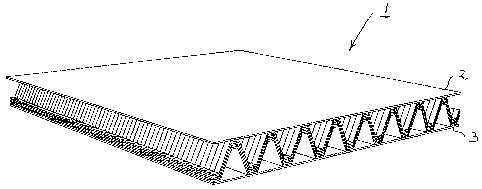Some of the information on this Web page has been provided by external sources. The Government of Canada is not responsible for the accuracy, reliability or currency of the information supplied by external sources. Users wishing to rely upon this information should consult directly with the source of the information. Content provided by external sources is not subject to official languages, privacy and accessibility requirements.
Any discrepancies in the text and image of the Claims and Abstract are due to differing posting times. Text of the Claims and Abstract are posted:
| (12) Patent Application: | (11) CA 2640721 |
|---|---|
| (54) English Title: | WALL ELEMENT |
| (54) French Title: | ELEMENT DE MUR |
| Status: | Deemed Abandoned and Beyond the Period of Reinstatement - Pending Response to Notice of Disregarded Communication |
| (51) International Patent Classification (IPC): |
|
|---|---|
| (72) Inventors : |
|
| (73) Owners : |
|
| (71) Applicants : |
|
| (74) Agent: | GOWLING WLG (CANADA) LLP |
| (74) Associate agent: | |
| (45) Issued: | |
| (86) PCT Filing Date: | 2007-01-16 |
| (87) Open to Public Inspection: | 2007-08-02 |
| Availability of licence: | N/A |
| Dedicated to the Public: | N/A |
| (25) Language of filing: | English |
| Patent Cooperation Treaty (PCT): | Yes |
|---|---|
| (86) PCT Filing Number: | PCT/NL2007/050019 |
| (87) International Publication Number: | WO 2007086737 |
| (85) National Entry: | 2008-07-29 |
| (30) Application Priority Data: | ||||||
|---|---|---|---|---|---|---|
|
A wall element comprising two outer layers extending at least substantially
parallel to each other, between which at least two intermediate layers are
provided, wherein each intermediate layer extends between the outer layers in
a zigzag fashion, each intermediate layer comprising first parts that extend
at least substantially parallel to the outer layers and second parts that
extend between adjacent first parts, wherein first parts of one intermediate
layer that face towards one outer layer are connected to said one outer layer,
and wherein first parts of the other intermediate layer that face towards the
other outer layer are connected to said other outer layer, a characteristic
feature being the fact that said intermediate layers are identical in shape,
with the intermediate layers being connected along their adjoining second
parts.
L'invention concerne un élément de mur comportant deux couches extérieures s'étendant au moins de manière sensiblement parallèle l'une par rapport à l'autre, entre lesquelles au moins deux couches intermédiaires sont mises en AEuvre, chaque couche intermédiaire s'étendant entre les couches extérieures en zigzag, chaque couche intermédiaire comportant des premières parties qui s'étendent au moins de manière sensiblement parallèle par rapport aux couches extérieures et des deuxièmes parties qui s'étendent entre les premières parties adjacentes, les premières parties d'une couche intermédiaire qui font face vers une couche extérieure étant raccordées à ladite une couche extérieure, et les premières parties de l'autre couche intermédiaire qui font face vers l'autre couche extérieure étant raccordées à ladite autre couche extérieure, une caractéristique étant le fait que lesdites couches intermédiaires sont identiques en forme, les couches intermédiaires étant raccordées le long de leurs deuxièmes parties contiguës.
Note: Claims are shown in the official language in which they were submitted.
Note: Descriptions are shown in the official language in which they were submitted.

2024-08-01:As part of the Next Generation Patents (NGP) transition, the Canadian Patents Database (CPD) now contains a more detailed Event History, which replicates the Event Log of our new back-office solution.
Please note that "Inactive:" events refers to events no longer in use in our new back-office solution.
For a clearer understanding of the status of the application/patent presented on this page, the site Disclaimer , as well as the definitions for Patent , Event History , Maintenance Fee and Payment History should be consulted.
| Description | Date |
|---|---|
| Application Not Reinstated by Deadline | 2012-01-16 |
| Time Limit for Reversal Expired | 2012-01-16 |
| Deemed Abandoned - Failure to Respond to Maintenance Fee Notice | 2011-01-17 |
| Letter Sent | 2009-07-16 |
| Inactive: Single transfer | 2009-06-02 |
| Inactive: Correspondence - Transfer | 2009-06-02 |
| Inactive: Cover page published | 2008-11-20 |
| Inactive: Declaration of entitlement/transfer - PCT | 2008-11-17 |
| Inactive: Notice - National entry - No RFE | 2008-11-17 |
| Inactive: First IPC assigned | 2008-11-06 |
| Application Received - PCT | 2008-11-05 |
| National Entry Requirements Determined Compliant | 2008-07-29 |
| Application Published (Open to Public Inspection) | 2007-08-02 |
| Abandonment Date | Reason | Reinstatement Date |
|---|---|---|
| 2011-01-17 |
The last payment was received on 2009-12-22
Note : If the full payment has not been received on or before the date indicated, a further fee may be required which may be one of the following
Please refer to the CIPO Patent Fees web page to see all current fee amounts.
| Fee Type | Anniversary Year | Due Date | Paid Date |
|---|---|---|---|
| Basic national fee - standard | 2008-07-29 | ||
| MF (application, 2nd anniv.) - standard | 02 | 2009-01-16 | 2008-12-19 |
| Registration of a document | 2009-06-02 | ||
| MF (application, 3rd anniv.) - standard | 03 | 2010-01-18 | 2009-12-22 |
Note: Records showing the ownership history in alphabetical order.
| Current Owners on Record |
|---|
| UNDA MARIS HOLDING N.V. |
| Past Owners on Record |
|---|
| WILHELMUS JAN REINIER KAREL SNEL |